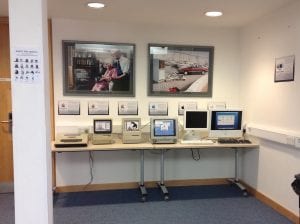
MA History of Design and Material Culture student Sarah-Mary Geissler investigates a display of defunct Apple computers at Aldrich Library

Image 1: Apple: The Early Years (1977-2004) currently on display at Aldrich Library, Moulsecoomb Campus, University of Brighton.
Out-dated computers sitting in the corner of a university library sounds like a dump rather than a museum, but Apple: The Early Years (1977-2004) shows that when it comes to technology, you need not delve too far into the distant past to reveal just how much society has changed. The humble museum in Aldrich is just a row of six Apple computers, all saved from office clear-outs at the University of Brighton. The information panels explain the growth of tech juggernaut Apple, while the machines illustrate the university’s relation to technology over 40-odd years.

Image 2: An Apple II Plus, formerly belonging to the Department of Computing and Cybernetics at Brighton Polytechnic.
Each object would have been at the forefront of tech in its time. The earliest model we have is the Apple II Plus from 1982, used in a former life by the Department of Computing and Cybernetics, when Brighton was still a Polytechnic. The computer may look like it’s missing something, however Apple didn’t actually provide monitors with their computers until 1984, instead it would’ve been compatible with a standard television set. Costing the equivalent of £3100 today, this device has 48KB of RAM, roughly 40 times less than most iPhones on the market.
By just observing these six discarded objects, we can see how tech goes from essential to obsolete in a few short years; each sat next to its usurper. Though the tech is old it’s not necessarily broken, it’s possible to interact with the machines and even switch some on. The display stirs various emotions in its viewers; younger students gaze at the early tech like Egyptian relics, ancient and mysterious. Other viewers are reminded of their own early computing education, when that very machine represented the cutting edge of innovation.
Technology evolves at a blistering pace, moving much faster than any other field and leaving increasing amounts of outdated gadgets in its wake. Apple, in particular, contests frequent accusations of designing tech with planned obsolescence, though the appeal of their products undeniably inspires consumers to discard “old” things before the end of their natural lifecycle. Experts estimated that 50-million tonnes of electronic waste would be produced this year, a staggering amount that these items very nearly contributed to. The Time-Warp Tech display is an innovative example of creating uses for objects otherwise considered useless.
To find out more about the Timewarp Tech project, follow their blog: https://blogs.brighton.ac.uk/ismuseum/
